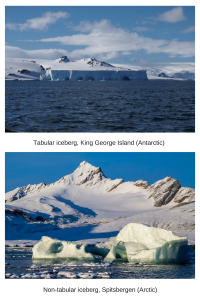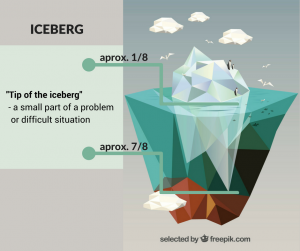Iceberg
An iceberg is a mass of floating ice that has broken off from the front of a glacier or ice shelf and slipped into the ocean (see also: calving). They tend to float for weeks in the open ocean until they melt away.
Approximately 1/8 of an iceberg’s volume is above the water surface.
Icebergs are classified by their shape and size. In general, there are:
- tabular (“table” shaped) icebergs
- non-tabular (“mountain” shaped) icebergs.
The smallest size category is “growler” and the biggest (according to U.S. Coast Guard Navigation Center) is “very large iceberg”, which is over 75 metres high, and over 213 metres long.
Large icebergs can pose a significant threat to ships.
Interesting facts: “Black” icebergs sometimes occur. They have a dark colour (due to sediments in the iceberg).
- Tabular and non-tabular icebergs (author: Dagmara Bożek-Andryszczak, Piotr Andryszczak)
- “Tip of the iceberg” (author: Dagmara Bożek-Andryszczak)




 This project (EDU-ARCTIC) has received funding from the European Union’s Horizon 2020 research and innovation programme under grant agreement No 710240. The content of the website is the sole responsibility of the Consortium and it does not represent the opinion of the European Commission, and the Commission is not responsible for any use that might be made of information contained.
This project (EDU-ARCTIC) has received funding from the European Union’s Horizon 2020 research and innovation programme under grant agreement No 710240. The content of the website is the sole responsibility of the Consortium and it does not represent the opinion of the European Commission, and the Commission is not responsible for any use that might be made of information contained.